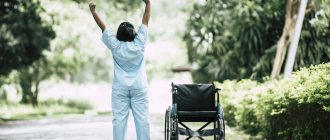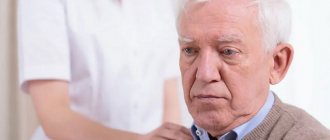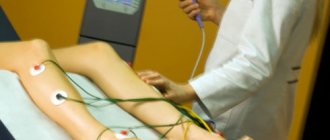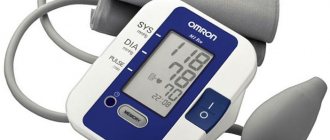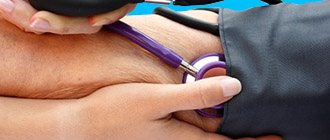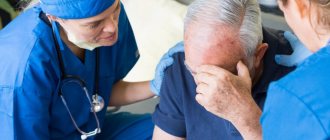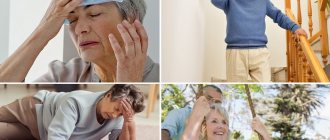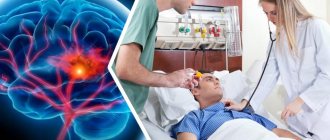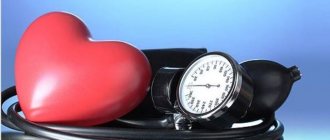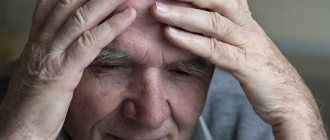Everyone experiences minor memory problems from time to time. Due to biological processes, memories can become blurrier as we age. For some older people, memory loss interferes with normal functioning, called dementia. However, most often, various disorders of mnestic function occur in persons who have experienced acute cerebrovascular accident - stroke.
According to the National Stroke Association, some degree of memory loss affects about a third of people who experience stroke. However, there are effective and proven methods that allow you to restore or improve mnestic function.
Memory deficits after stroke can vary. The degree of mnestic disorders depends on the patient’s age, the severity of the stroke, the area where the stroke occurred, and even the support that the person receives from family and friends.
Unfortunately, no medications can reverse memory loss. But where medications are powerless, simple steps can be taken: through exercise, therapy and rehabilitation, achieve memory recovery after a stroke.
Teaching basic skills for the recovery of older people after a stroke
Elderly people who have suffered a stroke and their relatives need to immediately understand that rehabilitation will not be easy. The recovery of patients after a stroke can be compared to the development of a child after birth: first he crawls, then sits, then stands on his legs and only then begins to walk. Nature has its own laws, and it is impossible to “skip” any stage of development. The same can be said about activities for the recovery of older people after a stroke: stopping or even taking a break from exercise means returning to the previous position.
The goal of recovery measures after a stroke is to reacquire self-care skills and everyday behavior.
The patient needs to perform a set of simple exercises to restore self-care skills. He learns to turn on the tap, use a toothbrush, put on things, fasten buttons - that is, perform actions that he could do before the stroke, like any healthy person. But now it seems impossible, because the ability to move has been lost. Therefore, any action is first disassembled into its components and worked out step by step. This is how the rehabilitation process begins.
In order to open a tap, you must first reach out to it. This action can be practiced even when an elderly person is in a supine position after a stroke. Perhaps he will perform this action more than once or twice, making mistakes and starting over, but in the end he will succeed. Other movements are practiced in the same way. By repeating the same actions every day, the patient brings them to automaticity, while neural bridges are formed in his brain, restoring connections between the action and a certain area of the brain responsible for its implementation.
This is difficult and painstaking work, but it is what helps older people who have suffered a stroke get on the path to recovery and regain lost skills.
We recommend
“Tumors in the elderly: causes, diagnosis and treatment” Read more
Why don’t people want to recover after a stroke?
The success of rehabilitation depends on the patient’s mood. People who have had a stroke may seem indifferent to their health. Very often they become irritable, aggressive, and whiny. They follow the doctor’s recommendations without much desire and prefer to lie down and watch TV. But with this approach there is no hope for a quick recovery. Relatives and friends need to muster all their will in order to successfully overcome the consequences of the disease. For some, it is enough to understand that the patient’s whims are not the result of laziness or bad character, but a consequence of damage to certain areas of the brain. Therefore, the primary task of loved ones is to help patients overcome their reluctance to exercise.
The rehabilitation period can last a long time, so both the patient and his family need to be patient. The effectiveness of the procedures depends on their systematicity and high-quality implementation.
What contributes to the restoration of motor functions in older people after a stroke?
First of all, efforts to rehabilitate stroke patients are aimed at restoring motor functions. This is due to the fact that in 95% of cases, victims experience varying degrees of paralysis. When a person begins to move, blood circulation improves, the threat of bedsores disappears, the patient can simply take care of himself and perform some simple actions. After this, the rest of the lost abilities are restored at an accelerated pace.
General recommendations for physical therapy for the recovery of older people after a stroke:
- The choice and schedule of exercises must be agreed with a specialist (physical therapy doctor or rehabilitation specialist).
- The intensity of the loads needs to be increased gradually, taking into account the actual capabilities of older people.
- As the load increases, it is necessary to complicate the technique of motor exercises: simple flexion-extension should be replaced by targeted subtle movements to restore the functions of the hands using auxiliary objects: rosaries, expanders, gymnastic sticks, exercise machines, circular elastic bands, musical instruments.
- If older people feel pain when moving, the load should be reduced.
- Before starting the exercises, it is necessary to prepare the muscles, stretch them with massage, rubbing or warming.
- The main goal of physical therapy is to relax muscles that, after a stroke, are in a state of hypertonicity (severe tension).
- No need to get overtired. The optimal schedule for performing gymnastic exercises is twice a day for an hour.
- During physical therapy classes, the breathing of older people should be monitored - check that its rhythm is smooth, inhalation and exhalation accompany a certain part of the exercise. For example, flexion should occur while inhaling, extension should occur while exhaling.
- It is advisable to have a loved one with older people when they perform stroke recovery exercises in a sitting or standing position. Relatives can support the patient or monitor the process; their presence will help avoid injury if the patient suddenly falls.
- Rehabilitation necessarily involves the prevention of contracture. The more time the limbs of older people are in the same position (bent at the knee or elbow), the stronger the muscles are fixed in the wrong position. Therefore, you need to place a soft cushion between the bent parts (in the elbow or popliteal fossa), which can be rolled fabric. To prevent contracture, you can also use a bandage or plaster to fix the straightened limb on a hard surface (board).
Each exercise can be repeated from 2-3 to 10-15 times. It all depends on the physical capabilities of sick elderly people. Once simple exercises have been mastered, it is important not to stop, but to move on, increasing complexity.
We recommend
“Health of the elderly: old age is not a problem” Read more
Why do memory impairments occur after a stroke?
The consequence of a blockage or rupture of a vessel is a stroke, and a person can suffer such a condition on his feet without noticing any changes. In some cases, the circulatory system suffers, which cannot deliver oxygen-enriched blood to a certain area of the brain and the cells of the cortex gradually die.
Cellular necrosis and lack of proper medical care remain the main causes of deterioration in health after a stroke. Against the background of such complications, partial or complete paralysis, immobilization of facial muscles and drooping of the corner of the mouth or eye, speech dysfunction and memory loss develop.
If the problem is noticed in a timely manner and qualified recovery after a stroke , it is possible to avoid the consequences. This situation is due to the fact that when a certain part of the brain is inactive, living cells can perform additional functions after a rehabilitation program.
It is impossible to predict the consequences of a stroke, but immediately after diagnosing such a condition, doctors can provide the necessary assistance. And by organizing proper care at home or placing an elderly person in a special rehabilitation boarding house, you can restore all lost body functions.
Restoring speech in older people after a stroke
The most intensive restoration of speech functions in elderly people is observed in the first 6 months after a stroke; in the case of extensive lesions or late treatment, it can last 2–3 years.
Depending on which areas of the brain were affected by the stroke, patients experience a motor or sensory form of speech impairment (aphasia). With the motor type, the patient:
- perceives speech by ear;
- understands what is being said to him;
- responds to requests;
- cannot formulate thoughts and pronounce phrases;
- does not want to read and write, as these processes are difficult for him.
With sensory aphasia, the patient does not perceive the words of others, he himself speaks incoherently, without controlling the speech flow. Such a patient can read, but will not understand the meaning of sentences; writing skills are completely lost. The speech of older people after a stroke is not meaningful enough and is accompanied by gestures. Patients try to explain what they want to say to others, but they do not understand them, and as a result they become irritated and offended.
In this case, you need to understand that even long exercises to restore speech after a stroke (lasting several months or even years) may not give a positive effect. In 30–35% of cases, speech functions return spontaneously and not gradually.
In order for older people to start speaking after a stroke, they need to constantly hear sounds, words, and expanded speech.
During rehabilitation, it is necessary to follow the principle of the sequence of stages. You can start classes by practicing the pronunciation of individual sounds, then you can move on to syllables, simple and complex words, and then to small poems and sentences. When working with older people after a stroke, you can help them a little - pronounce the initial part of the word, and they will finish the ending themselves.
Also, to restore speech, older people are recommended to listen to music and sing. Often, patients after a stroke cannot speak normally, but retain the ability to sing. In this case, you should definitely try to sing - this will activate speech restoration.
Exercises to rehabilitate facial muscles are best done in front of a mirror. Such classes are especially indicated in cases where an elderly person has a distorted face after a stroke. To do this you need to do the following:
- bare teeth;
- curl and protrude your lips into a “tube”;
- opening your mouth, push your tongue forward as much as possible;
- alternately bite your upper and lower lips;
- lick your lips with your tongue in a circle, first in one direction, then in the other direction;
- pull the corners of your mouth up, as if smiling.
During speech rehabilitation classes with older people, you can use the following:
- showing the patient cards on which letters, syllables and words are written, asking him to compose a sentence from them and read it;
- encourage the patient to communicate: ask questions, sing together, recite poetry;
- listen to your favorite audiobooks with the patient and retell their contents;
- look at the pictures and then ask them to describe them.
If relatives conduct classes with a patient who has suffered a stroke at home, it is important to be kind to even the slightest attempts by the patient to pronounce words, to encourage him, and not to correct mistakes. To help older people overcome their speech impediment, you need to be persistent and constantly communicate with them.
We recommend
“Senile dementia: causes, symptoms, treatment” Read more
Medical certificate
Cognitive (i.e. cognitive) functions:
- attention (understands a person’s ability to maintain the level of mental activity necessary for cognition);
- perception (the ability to construct, based on information that enters the brain from the senses, integral images and ideas);
- gnosis (implies the ability to understand formed images and associate them with categories of the mind);
- memory (the ability to remember, store and reproduce provided information);
- intelligence (understands the ability to perform actions with acquired information, i.e. perform analysis, comparison, evaluation, generalization, apply in solving problems);
- speech (implies the ability to communicate through a symbolic sign system, i.e. language);
- praxis (the ability to form and include motor skills in activities, build, memorize and automate a sequence of movements).
Cognitive impairment refers to a decrease in memory, mental performance and other cognitive functions. Comparison is made with the individual norm.
Appear as a result:
- local brain damage;
- decompensation of previous cerebral disease;
- development of acute encephalopathy.
Clinical picture depending on the location of the affected area (brain lobe):
- anterior frontal
– violation of planning and control;
- posterior parts of the left frontal
– Broca’s aphasia, apraxia (the patient can outline a plan of his actions required to perform a complex motor act, but is not able to perform it);
- left parietal
– associative aphasia, ideomotor apraxia (cannot outline a plan of sequential actions to perform a complex motor act), Gerstmann syndrome, body diagram defects, alexia, agraphia;
- left junction of parietal and occipital
– optical-spatial agnosia, acalculia, constructive apraxia (cannot form a whole object from its parts);
- right parietal
– anosognosia, ignoring ½ space;
- left temporal
– Wernkike aphasia and/or amnestic type;
- right
– amusia, dysprosody, arrhythmia;
- occipital left
– optical-object agnosia, isolated alexia;
- right occipital
– facial, visual color agnosia;
- hippocampus, thalamus, mediobasal frontal
– amnesia.
Symptoms:
- deterioration in concentration;
- defects in executive functions in the form of decreased intellectual flexibility (manifested by inertia, perseveration) and cognitive control (impulsivity appears);
- constructive dyspraxia;
- bradyphrenia;
- memory impairment in terms of incomplete reproduction.
The medical and social significance of the deviations lies in the decrease in the patient’s performance and the emergence of problems with everyday and social adaptation after a stroke. This negatively affects the quality of life of both the elderly and their family members. Due to a decrease in the effectiveness of neurorehabilitation, a poor prognosis regarding the completeness of functional restoration is given. The effectiveness of therapy and prevention of the main and concomitant diseases also decreases. As a result, life expectancy decreases.
A set of measures to restore memory and intelligence in older people after a stroke
It is better to begin rehabilitation of mental abilities while patients are in the hospital, after the general condition after the stroke has stabilized. But the brain of older people should not be subjected to excessive overload.
Restoration of memory functions is accompanied by preliminary drug therapy aimed at maintaining stroke-damaged nerve cells. Elderly people are administered the appropriate drugs (Actovegin, Thiocetam, Piracetam, Cavinton, Cortexin) intravenously, or they take them in tablet form. The therapeutic effect of the use of drugs appears slowly, over 3–6 months. The course of medication is repeated after 2–3 months.
When restoring memory, the following rehabilitation actions are carried out:
- Train your memorization ability: listen and repeat numbers, words, short poems. First, you need to achieve short-term memorization - when the patient can repeat information immediately after listening to it. Then the memorization period should be increased - for example, the patient will independently pronounce the numbers when asked to count.
- Look at photographs and videos, while remembering and pronouncing the names of all the objects depicted.
- Play boardgames.
We recommend
“Diabetes mellitus in older people: features of diagnosis and treatment” Read more
What are the manifestations of memory impairment?
Modern medicine proposes to consider human memory on the basis of two components that play an important role in its formation. These are short-term and long-term memory, responsible for the safety of ever-memorized information used in mental processes.
After a stroke, memory loss of various types can be diagnosed, and after such a diagnosis, the recovery process can begin with an individual selection of techniques:
- verbal memory impairment;
- visual memory disorders;
- loss of motor skills;
- disturbances of emotional-figurative memory.
The most complex and difficult to recover cases include vascular dementia, which cannot be cured. Such a diagnosis cannot be considered as a death sentence, although elderly people with dementia after a stroke completely lose adequate perception of the surrounding reality. With a properly selected course of rehabilitation and well-carried out recovery, it is possible to slow down the process of deterioration of a person’s condition and adapt it to reality.
Home care rules for the rapid recovery of older people after a stroke
In the first days after a stroke, you should contact a specialist in physical therapy so that he can teach relatives how to carry out the necessary exercises with an elderly patient at home. In this case, the rehabilitation process will go faster and more efficiently.
Practice proves that the best results in the recovery of older people after a stroke are obtained by a combination of active treatment with physical activity started as early as possible. If a person survives, it means that he has opportunities for rehabilitation.
WHO has published a program that outlines the principles and steps for returning affected people after a stroke to an active life and restoring their life-saving skills. The document also describes all the necessary exercises that can be done at home.
Recovery of older people after a stroke is possible only with the help of loved ones or special personnel. It is impossible to go through the rehabilitation process on your own; it is a very difficult task.
Elderly people during rehabilitation after a stroke need not only moral support, but also practical assistance. Restoring the ability to move occurs as follows: a relative takes the patient’s immobile limb and begins to perform simple movements with it - stretching, straightening or bending, turning, simulating grasping, etc. Doing such movements at home is not difficult. It takes time for the brain to remember how certain muscles work. Time will pass, and the patient will begin to slowly move the limb, before this he will have to be frequently corrected and asked to repeat the exercises. The restoration of active movements that the patient can perform independently will mean the end of rehabilitation measures.
Gross motor skills return most quickly. The ability to make precise movements with the hand and fine facial expressions after a stroke will return at the very end of the last recovery period.
The exercises must include verbal and visual components; this is necessary for proper treatment. During classes, you need to describe and show sick elderly people everything that happens. This promotes the formation of new neural connections.
The exercises are performed in front of a large mirror so that the person can see himself in full height. Some time should pass between saying what will happen now and the actual action. The assistant says: “Now we will raise our hand,” waits for some time until the elderly patient understands the meaning of what was said, and only then raises his hand. The patient sees all these actions in the mirror. Such activities also help restore memory.
Treatment at home shows very good results, because so much love and care is invested in it from loved ones. We must remember that perseverance will be the main assistant.
Of course, when conducting recovery classes, you always need to realistically assess the capabilities of an elderly person who has suffered a stroke. In this case, a doctor will always help, who will tell you how to act. It is important for relatives to follow one more rule: do not exclude an elderly patient from the life of the family, do not let him become obsessed with the disease.
Relatives are also advised not to take manifestations of anger and aggression on the part of the patient to heart, and to learn not to react to such emotional outbursts. In this case, you need to try to put yourself in the place of a person whose life seems to have hit a wall with acceleration. The consequences of a stroke are manifested, among other things, in emotional disorders, and this is facilitated not only by severe organic brain damage, but also by the new social status of an elderly person: he falls out of his usual environment, is deprived of work, pleasure, and communication. Not everyone can survive this.
The behavior of relatives and their reaction to what is happening determines how the atmosphere in the family will develop in the future and how the recovery of the elderly patient will proceed. If you don’t let negativity sprout in your soul, then you can overcome any difficulties. If you follow the lead of scandals and reproaches, the little that could still be saved will be destroyed.
We recommend
“Low blood pressure in older people: causes, symptoms and treatment” Read more
Basics of cognitive rehabilitation after stroke
Based on the early systematic approach given in the schools of Anokhin, Vygotsky, Luria and others.
Basic principles:
- stimulate natural mental recovery;
- training of individual defective cognitive functions and familiar everyday activities;
- assistance in compensating for the lack of certain cognitive functions and limited everyday skills;
- use of compensatory equipment and assistance from third parties;
- transformation and structuring of the environment.
Restorative training methods are divided into two types. The first is modal-nonspecific
aimed at training neurodynamic parameters and thinking, verbal and non-verbal influence. If necessary, special software is used to stimulate neurodynamic parameters. Research is currently underway to clarify the effectiveness of targeted computerized indirect stimulation of certain areas of the brain for the development of narrowly targeted rehabilitation techniques. At the moment, it is not known for certain whether training one cognitive function using computer programs helps improve it, or whether the training affects other cognitive brain functions.
Modal-specific
The methods are based on the restoration of cognitive functions due to the preserved modality with a gradual dosed complication of the action program.
A set of non-drug methods for restoring cognitive impairment includes:
- diet: eating enough fresh fruits and vegetables, vegetable oil, fresh fish and limiting the consumption of foods rich in cholesterol and table salt, reducing excess weight;
- cognitive gymnastics;
- cognitive training;
- psychological and behavioral correction methods, where efforts are mainly aimed at improving sleep, spiritual state with the help of special practices, art and music therapy;
- psychotherapeutic techniques;
- meditation and yoga classes.
Cognitive gymnastics
This is a set of special physical exercises, including coordination movements and elements of acupressure self-massage. They help establish connections between the kinesthetic, visual, optomotor and auditory systems. The exercises are conditionally divided into groups:
- General developmental.
- Aimed at developing coordination (bodily).
- To stretch the muscle tissue of the body (stretching).
- To increase body energy and relaxation.
First, the exercises are performed lying down or sitting on a chair. The complex is gradually expanding. The general condition of the patient and his well-being are taken into account. The patient is offered exercises from a standing position, with support on a chair, without support and while walking. 1-2 minutes are allotted to perform each exercise at a slow and smooth pace. Gymnastics are carried out daily, taking into account the developed program and the general condition of the patient. One session in a gentle motor mode for 10-15 minutes, a gentle training session for 15-20 minutes, a training session for 25-30 minutes. The lesson consists of 3 parts: preparatory, main and final.
Indications for cognitive gymnastics are cognitive deficit, decreased attention and memory impairment. Contraindications – there is no verbal contact with the patient, there is total aphasia, general health is poor.
Cognitive group training
Conducted in groups of 12-15 people. Duration – 75-90 minutes. The specialist must take into account that the presence of people of the same sex of the same age negatively affects the elderly. They are more likely to attend classes (especially older adults with severe cognitive impairment) if the group contains only peers of the same sex.
When forming a list of participants in each group, the severity of cognitive defects is taken into account. It is advisable to attend lessons for patients with varying degrees, since this stimulates natural competition, and therefore increases work activity. However, the specialist must adhere to an acceptable threshold of emotional stress in order to avoid the opposite effect.
If the lesson involves written assignments, then the material is given to each group member in printed form along with clear instructions. How to perform the exercise is also explained orally. This is necessary so that everyone understands the essence correctly.
Each lesson contains a variety of exercises that are different from each other. When drawing up a program, individual preferences and treatment dynamics are taken into account. At the end of the work, errors are analyzed, but attention is focused not on “failure”, but on the fact that the patient will definitely succeed. To diversify the lesson, game forms of presenting material and educational games are used. This helps not only relieve psychological tension, but also improve the communication skills and mood of the participants. The training is carried out in conjunction with psychopharmacotherapy.
Goals:
- Correct memory through restructuring and integration with perception and thinking. A variety of mnemonic methods are used.
- Activate processes of all types of attention.
- Develop and train logical thinking skills that are responsible for the formation of focus, consistency and flexibility of mental conclusions.
- Develop imaginative thinking, without which associative memory cannot be restored.
- Involve each group member in the training process, which helps improve communication skills.
- To overcome the social isolation of patients, to develop the skills of socially adapted behavior in a group.
- Expand your general horizons to motivate you to engage in other forms of work and leisure activities.
- Improve verbal skills by increasing your active vocabulary.
- Involve each group member in creativity that promotes the search for original cognitive and behavioral tactics.
- Learn to switch attention from negative emotions to productive activity.
- To create a favorable emotional atmosphere, the patient should feel satisfied with the results of his work. This allows one to overcome intellectual and social anhedonia.
- Train regulatory functions by observing a change in mental work with rest and other types of active activity.
- Develop criteria for assessing the dynamics of the effectiveness of cognitive restoration.
- Form motivational attitudes for individual work in everyday life.
Lesson order
The lesson begins with “Getting Acquainted”, when each participant introduces himself and answers the specialist’s questions about his preferences. The next person must introduce himself and also tell about the previous member of the group: his name, age, what he answered. This helps to start a conversation, train your memory, and relieve tension. Next come light physical exercises aimed at warming up the muscles (warm-up).
The main part is exercises for all types of cognitive functions: attention, memory, thinking and regulatory processes. Some tasks are labor-intensive and require participants to concentrate or jointly search for the optimal solution.
The end of the lesson is emotional relaxation in a playful way. For example, “Russian Lotto” or “Trimino”.
Examples of exercises to develop attention
- Closing your eyes, mentally draw the numbers from 0 to 9, only the tip of your nose acts as a brush.
- The specialist shows an unusual object for a short time and hides it. Patients describe it in detail.
- Participants must count from 1 to a given number in a circle. You need to focus on those numbers that fit certain criteria.
- Count out loud in a circle from 1 to a certain number. When a number appears, for example, with “2”, say not it, but the phrase “I won’t get it wrong.” The count starts again.
- Participants are given clippings from magazines (everyone's interests are taken into account). A person must carefully read the article and cross out words that fit the given criteria. At the end, everyone is asked to talk about what they read (they are not warned about this requirement in advance).
- Group members sit with their eyes closed. The patient is asked a question such that the answer provides the opportunity to notice small details in the perception of others.
- Closing your eyes and ignoring extraneous sounds and thoughts, think first about your plans for the evening, then about the book you read the other day and, then, remember a bright positive event in your life.
- Each participant is given tables from a set of letters. Words (nouns only) are hidden among them. The participant must find them.
Examples of memory development exercises
- Sitting with your eyes closed, imagine your room. 10 words are voiced by the presenter. They should be remembered and placed in the presented room in the order stated.
- Under dictation, a series of words are written down on a piece of paper in a column. The participant must select a different association word for each of them and write it down side by side, but in a different order. Then close the first column and restore it using associations.
- A mini-story is told so that participants can form strong visual images to remember key words.
- First, the participants sort out among themselves what associations they have in relation to this or that number. The next stage is when the presenter announces the sequence of names of these items. Participants must recreate the digital sequence.
- You need to make a diagram of a known object from memory, for example, the location of rooms in an apartment.
Examples of exercises for training figurative and logical thinking
- You need to mentally transform the proposed Chinese characters into objects, people or phenomena
- The group is divided into 2 teams and seated opposite each other. One is given cards with terms. The team must work together to explain to the opponents the functional definition of each concept. The second team's task is to guess. Then there is a change of roles.
- A long word is given. From its letters, participants must create the maximum number of new ones.
- The group is divided into teams of 3-4 people. Large fireplace matches are used. From these, equalities are laid out on the table according to a certain condition. The team’s task is to correct the equation or make new ones.
- You are given 2 words, you need to make a logical chain with them. Performed in turn by all participants.
- Letters are selected from the Russian alphabet and assigned numbers from 1 to 9. The participant names the digital combination, and other members of the group must guess the word.
- A set of words of various semantic similarities is given. From these, patients must write a short story that is logical and includes all the words.
Riddles, logic, puzzles
These are fun exercises that allow you to train all cognitive functions.
"Filward." Each person is given a sign with letters. The presenter asks riddles on a topic that is interesting to all participants. The clue words need to be found and marked in the table.
How long does it take to recover memory after a stroke?
Rehabilitation procedures after a stroke carried out by specialists at our private boarding houses include an integrated approach. This means that in addition to memory restoration, psychologists work with patients to help stabilize their psycho-emotional state and return to normal life.
The process of memory restoration and its duration depend solely on the diagnosis and the degree of destruction of the neural network. It is very important that the patient immediately after a stroke begins to undergo a rehabilitation course and follows all the doctor’s instructions so that the changes become reversible.
Having lost memory and part of cognitive abilities, a person feels disoriented and often becomes depressed. For older people, it is important to organize optimal conditions for therapy and create comfortable psychological conditions under which rehabilitation will be as effective as possible.
Is memory restored after a stroke?
Destroyed neural connections can be restored and this will provide the opportunity to partially or completely restore a person’s memory.
But for this it is necessary to create optimal conditions and develop a set of techniques, regularly conduct classes and monitor the current state of health of an elderly person:
- systematic memory training and activation of thought processes;
- drug therapy using memory improving drugs;
- using intellectual games and exercises to strengthen memory.
Classes and exercises should not overload the brain; in a person’s life it is important to find time for rest and entertainment. A specialized private boarding house for the elderly in the Moscow region offers unique and individually adaptable rehabilitation program complexes for people who have suffered a stroke.
